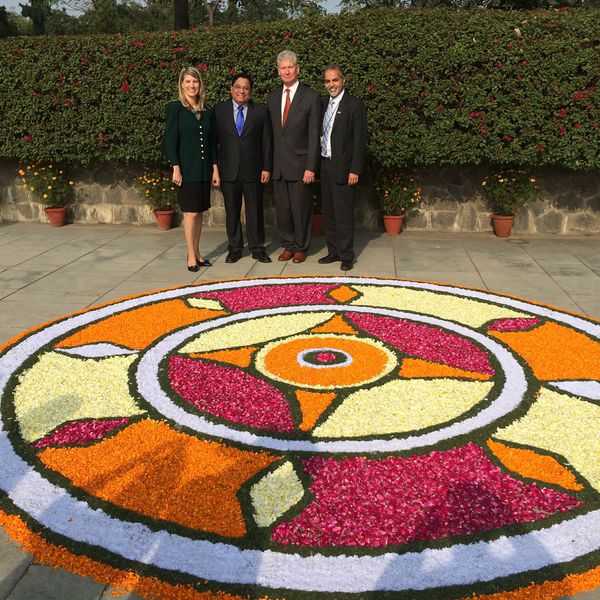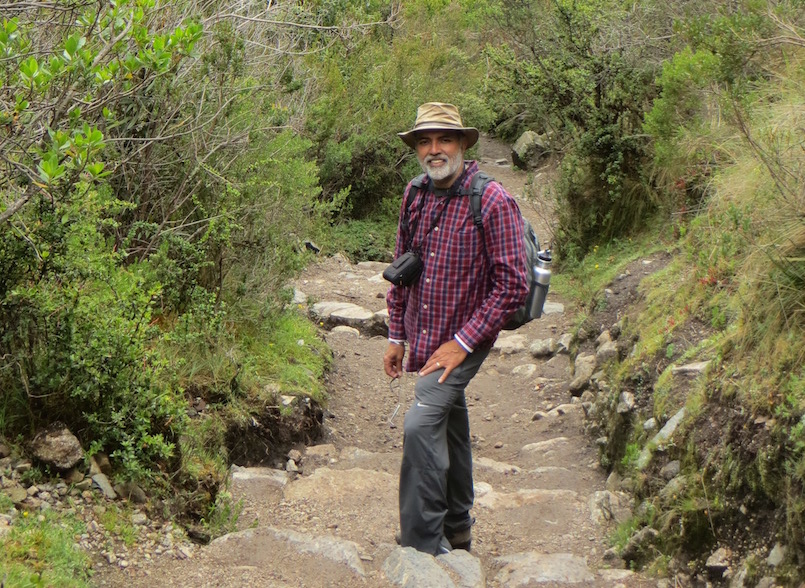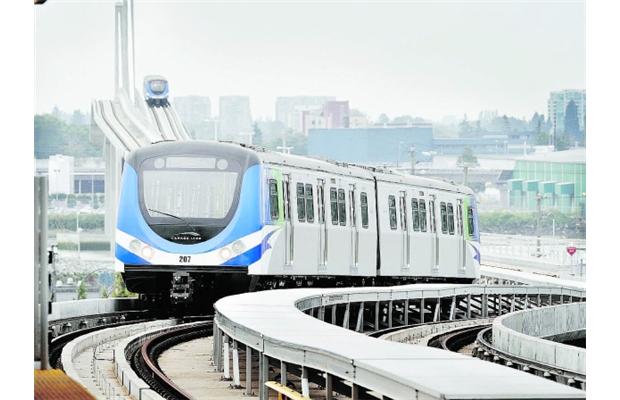
Asia Pacific Foundation Looks to Expand to South Asia
The new president of the Vancouver-based think tank is looking to expand Canadian relations with South Asia and Southeast Asia.
Asia Pacific Foundation’s new president, Stewart Beck, was Canada’s former High Commissioner to India, and has extensive experience working in the region. Barj Dhahan met with Mr. Beck in New Delhi earlier this year during a visit to India with the Governor General.
Business in Vancouver interviewed Beck and Barj Dhahan about the appointment and the value of expanding ties with South Asia and Southeast Asia.
Read an excerpt from “Stewart Beck: East-West Connector,” published in Business in Vancouver on August 25, 2014:
Vancouver businessman and philanthropist Barj Dhahan said Beck was a leader in focusing on not only entrepreneurship between India and Canada but also education during his tenure as high commissioner. Beck’s appointment to the foundation is timely, given the growth and opportunities in South Asia, said Dhahan, who is past chair of the Canada India Foundation.
“Stewart’s appointment is very timely because, as a country and a province, we are certainly looking at Asia, not just at China and Japan but all of Asia, South Asia and Southeast Asia. It’s timely that the foundation has a broader focus on all of Asia,” Dhahan said.
Beck is eager to apply his India experience, coupled with a career-long belief in educating young people on what he calls “business ecosystems,” to shape the next chapter for the foundation.
He wants the foundation to be well positioned to act as a catalyst to engage young entrepreneurs on both sides of the Pacific as regional Asian economies grow stronger.
“It’s the Wayne Gretzky thing: skate to where the puck is going to be,” Beck said. “That’s part of the role I think the foundation has.”
Beck’s hockey analogy comes from experience. Dhahan said that, along with other Canadian officials, the former high commissioner would host an ice hockey tournament in northern India to introduce young Indians to Canada’s national sport as a bridge-building exercise. He was known to bring shipments of hockey sticks, skates and pads from Canada to India.
“A lot of people in India know about our national sport as a result,” said Dhahan.
That kind of bridge building pays dividends for both countries, Dhahan said.

Richard Bales (Canadian Consul General, Mumbai) Governor General David Johnston, a guest, and Stewart Beck.
Read the full story at Business in Vancouver.

Beyond Daycare: Providing Options for Young Parents
We need a comprehensive childcare program with a variety of options to ensure strong, healthy, and happy Canadian families.
A few weeks ago, The Vancouver Sun featured a front-page article on the issue of daycare costs in British Columbia, referencing a report from the Surrey Board of Trade. The report presents the case for providing $10/day childcare for British Columbians, and calls on the federal government to create a national child-care program. The argument presented is largely an economic one, focussing on the need to ensure that young parents are able to participate in the workforce. While this is an important point, we need to also look at the social, health, and other benefits of supporting young families in our country, and to provide parents with childcare choices, including the option to stay at home.
There are strong arguments in favour of subsidized daycare programs as well as evidence of their benefits from as nearby as Quebec. In that province, parents of all economic backgrounds can access provincial childcare for only $7/day. This ambitious 2.2 billion dollar program has seen spectacular results over the last 15 years, including a 22% rise in working mothers, an 81% rise in after-tax income to families, a 50% reduction in parents on welfare, and a 50% reduction in child poverty. These results mirror other countries where investments in childcare have boasted long-term economic returns.
While the program in Quebec is not without flaws (for example, there are still not enough spaces for all of the province’s children), its economic results are evidence enough for subsidized childcare options across the country. There are also many other compelling arguments for providing quality daycare for our nation’s children: it can help parents achieve a healthier work-life balance, contributing to happier relationships and reduced health problems, and it provides children with an early start to their education, the benefits to be seen for years to come.
But daycare is not the only way to support young parents; there are many benefits to providing extended parental leave for mothers and fathers who want to care for children at home. The benefits of longer parental leave include economic returns such as higher rates of employee satisfaction and higher employee retention, as well as many health and social benefits. For example, allowing parents time off to take care of their kids has been shown to contribute to the long-term health of children, lower rates of depression in women, increased fertility rates, and when parental leave is shared between mothers and fathers, it can contribute to greater gender equality.
Scandinavian countries frequently top charts for having the “happiest” people in the world and being some of the “best” places to live. They are also some of the best places to be a parent. In Sweden, parents get 480 days of paid leave, 60 of which must be shared between both parents, and in Norway they have just over a year of paid leave plus the option of an additional year unpaid. In Finland, parents are entitled to a childcare allowance if they choose to stay home with their children for up to three years. They are also entitled to shorter work hours until the end of the child’s second year in school at age 9 (since formal schooling only begins at age 7 in Finland), as well as subsidized daycare.
The federal Liberals call for a national strategy to provide universal early childhood education and care that ensures no child is excluded due to cost or any other reason. The economic and social benefits of such a program are clear, but I hope that the conversation does not stop there. Young parents must have choices, including the option to raise their children at home without fear of losing their jobs. We should also look at options for providing subsidies to grandparents, nannies, and others who provide childcare as is currently being debated in Australia.
Today’s children are the future of our country. Investing in childcare, including affordable daycare, extended parental leave and benefits, and other family supports, should be of utmost importance for all Canadians. Since each family is unique, we need a comprehensive program with a variety of options to ensure strong, healthy, and happy Canadian families.

5 Best Hikes in Beautiful British Columbia
One of my favourite ways to enjoy nature and bond with my family is to go hiking. British Columbia has a bounty of outstanding hiking trails nestled within beautiful forests and parks.
 In November 2013, I was fortunate enough to visit Peru and experience the beautiful landscape with my son, Gabriel. We hiked the Inca Trail and climbed to Machu Pichu – it was a lifetime high for me! We’re lucky to have stunning forests and parks in British Columbia, and I highly recommend exploring them one weekend with your friends and family. It’s a great way to connect with nature, bond with family, and do a healthy activity.
In November 2013, I was fortunate enough to visit Peru and experience the beautiful landscape with my son, Gabriel. We hiked the Inca Trail and climbed to Machu Pichu – it was a lifetime high for me! We’re lucky to have stunning forests and parks in British Columbia, and I highly recommend exploring them one weekend with your friends and family. It’s a great way to connect with nature, bond with family, and do a healthy activity.
Here are 5 of my favourite places to hike in BC:
- Pacific Spirit Park (UBC Endowment Lands). Over the years I have walked all the trails within this park, and visited all the beaches. I like walking the trails during autumn, especially on rainy days. It’s an incredible experience.
- Garibaldi Provincial Park. Years ago, along with four friends I camped on the shores of Garibaldi Lake on a full moon. It was a truly magical and mystical experience to spend the night there. I love the thrill of climbing through the chimneys to the top of Black Tusk. I have done this three times.
- Cathedral Grove by Cameron Lake in the McMillan Park. I have childhood memories visiting this area many times when my family lived in Port Alberni. The ancient trees, some older than 800 years, stretching heaven-ward are awesome. It is amazing that these trees were there before Columbus reached the Americas in 1492!
- Horne Lake Caves Provincial Park near Qualicum Beach on Vancouver Island. I visited this park with my grade 8 class. Going into the caves was scary but exciting. I had never been ‘underground’ before. It’s a must visit for anyone interested in caves.
- Osoyoos Irrigation Canal Trail. There are great views of the lake as one walks through beautiful apple, cherry, and peach orchards. This area is the only ‘desert’ in Canada. My wife Rita’s family has a lakeshore property on the US side of the desert, and each summer, we went to Osoyoos/Oroville for at least a few weeks. I have wonderful memories of hiking in the mountains around the lake.
We are blessed with such amazing natural beauty, landscapes and hiking trails in BC. We should all try to walk the hikes as much as we can. It’s good for the body and spirit!

Canada Needs an Infrastructure Plan
All levels of government must collectively identify needs.
Op-ed originally published in The Vancouver Sun on August 5, 2014
We need to invest now in public transit to accommodate the one million new residents expected during the next 30 years, yet there is much debate about which projects to focus on and where the funding will come from, according to Barj Dhahan, the founder and chief executive officer of Sandhurst Group.
Former chief economist and senior vice president of the World Bank, Justin Yifu Lin, was presented in May with an honorary doctoral degree from UBC for his contributions to the field of economics and development. Lin has written extensively about the importance of investments in infrastructure to promote healthy economies. He has recently proposed the development of a Global Structural Transformation Fund, sparking me to reflect on the need for a comprehensive infrastructure plan for Canada.
Investing in infrastructure has been shown to be a key factor in the development of robust economies. According to the World Bank, a 10-per-cent increase in infrastructure investment leads to a one per cent growth in GDP. Lin has said that, “Such investment also creates jobs, both in the short term, by creating demand for materials and labour, and in the long term, for related services. For example, every $100 million invested in rural road maintenance translates into an estimated 25,000-50,000 job opportunities.”
In cities, improving transit infrastructure not only creates jobs, but has also been shown to increase productivity as people are more easily able to get to and from places of work. The economic benefits of infrastructure investment are clear, but how do we ensure the most efficient and effective infrastructure planning?
In late March, the New Building Canada Plan was launched by the federal government, allocating $53 billion during 10 years to infrastructure development. While the plan includes funds to address needs at different levels, there is confusion about how this money will be allocated, when it will be allocated, and who will make those decisions.
There are critiques that the plan does not make sufficient funds available for the first two years, and many municipalities are left wondering if they will be able to address serious local infrastructure problems any time soon.
What is troubling about this plan and similar funding sources, is that money is allocated based on a competitive process. Provinces and cities must submit applications to fund their specific needs and hope their project will be selected. The problem is exemplified by the current debate around public transportation investments in Metro Vancouver.
It is clear we need to invest now in public transit to accommodate the 1 million new residents expected during the next 30 years, yet there is much debate about which projects to focus on and where the funding will come from. Metro Vancouver mayors recently presented a transportation investment plan covering major projects for the next 10 years but the provincial government rejected the mayors’ hope to use carbon tax revenues to help fund the projects.
Should each municipality be left on its own to come up with the funds? Should Surrey compete against Vancouver to fund each of its proposed rapid transit projects?
Currently, there is no sustained source of federal funding to address transit or other core infrastructure needs for municipalities; the ongoing debate between Metro Vancouver mayors and the province highlights this major gap.
What is needed is a comprehensive infrastructure plan for the country based on ample dialogue between experts and all levels of government that clearly lays out an investment plan for the short, medium, and long-term with funds earmarked for specific projects.
Stakeholders would need to come together to clearly define the country’s major infrastructure needs and to formulate agreements in principle about project priorities, criteria, and funding sources in order to make efficient decisions.
Such a strategy would contribute to economic growth not only by investing in infrastructure, but also by facilitating strategic planning to ensure that projects are undertaken in a timely manner and on budget. It would allow for government, industry, labour and community groups to strategize regarding material and labour needs, generating a steady flow of employment opportunities for Canadians.
Most important, it would not pit municipalities against each other, but instead would include regular dialogue and consensus-building between all levels of government to make sure no one is left in the dark, both figuratively and literally!



